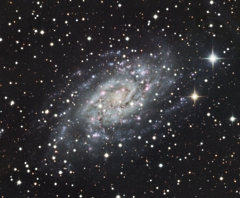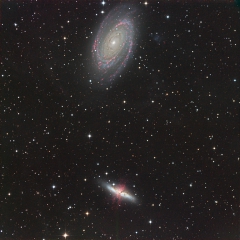Beginner and Intermediate
PixInsight Workshops
By Vicent Peris
16 – 17 and 23 – 24 September 2017, Hong Kong
These workshops will give amateur and professional astrophotographers alike a chance to work with Vicent Peris, a member of the PixInsight Development Team, and learn directly from him the techniques and tools he has developed on the PixInsight Platform.
The workshops will take place at the TSL Training Center in Hong Kong from September 16 to 17 and 23 to 24. These weekend workshops are organized in different knowledge levels, providing the user a more flexible opportunity to learn image processing. Each of these beginner and intermediate workshops will be offered for up to 15 people.
Workshop Dates and Venue

Photo by Diego Delso
The workshops will take place at the TSL Training Center in Hong Kong during the following dates:
- September 16 to 17 – Beginner Workshop
- September 23 to 24 – Intermediate Workshop
Workshops start at 9:30 AM and end at 5:00 PM.
The TSL Training Center is located at the below address:
1/F Summit Building
30 Man Yue Street, Hung Hom, Kowloon, Hong Kong
Contact Information
For local and logistic support please contact Ms. Eyonna Mak at admin@remoteastronomy.com.
Please register to the workshops according to your preference:
Beginner Workshop — September 16 to 17
With a total duration of 15 hours, the registration price is 150 Euros. Click the button below to register.
Intermediate Workshop — September 23 to 24
With a total duration of 15 hours, the registration price is 200 Euros. Click the button below to register.
This workshop is now SOLD OUT. Thank you so much, and see you in Hong Kong!
Workshop Sponsors
Workshop Methodology
The beginner and intermediate workshops have specific methodologies. The beginner workshop will be focused on the elementary techniques:
- Workflow with DSLR and one shot color cameras.
- Color calibration techniques. Presentation of the new PhotometricColorCalibration tool.
- HDR techniques.
- Full example with DSLR data showing the workflow from the beginning to the processed image.
The intermediate workshop will be focused on more advanced techniques:
- Narrowband imaging.
- Advanced preprocessing tools, including in the latest version of PixInsight.
- Full example with CCD data showing the workflow from the beginning to the processed image.
Workshop Documentation
Workflow Charts
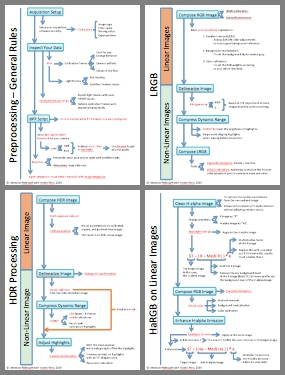
Each participant will be given a full set of PixInsight workflow charts describing the techniques reviewed during the weekend. Covering the main concepts in a visual style, these charts will help you to carry out your own work at home.
Participants of the intensive workshop will have additional workflow charts describing the techniques reviewed from Monday to Wednesday.
Workshop Program — Beginner

Learning to Navigate the PixInsight Platform
An introduction to the PixInsight platform and its graphical user interface.

The Color Camera Workflow
We'll review the most basic image processing techniques for astrophotography applied to color cameras, starting from the preprocessing of the raw pictures to the basic postprocessing. It's strongly recommended that participants watch Vicent's videotutorials about color calibration and LRGB techniques prior to attending the workshop.

Dynamic Range Management Techniques
PixInsight has a highly automated workflow for the dynamic range management of the image. We'll review the use of HDRComposition and HDRMultiscaleTransform tools as well as basic masking techniques for local contrast enhancement.
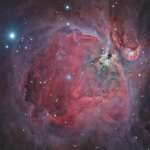
Start-to-Finish Example — M42
A DSLR-based example with data provided by Anthony Park and Al Vinjamur. This example will cover mainly the following topics:
- Data preprocessing with DSLR images.
- Color calibration.
- Stretching and dynamic range compression.
- Contrast management.
- Basic denoising.
Workshop Program — Intermediate

The Hubble's Palette
Building a Hubble's palette composite in PixInsight is extremely easy. We'll review an effective workflow composed of only four steps that gives a good tonal representation in these narrowband images.
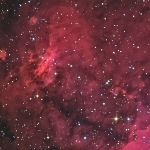
HaLRGB Composition Techniques
A review of the effective methods designed by Vicent Peris to enhance line emission objects in your broadband images.

Start-to-Finish Example — M51
Data provided by Frank Wilburn (click on the image to see a full-size version. This example will cover mainly these topics:
- Data set inspection with Blink and SubframeSelector.
- Preprocessing with the BatchPreprocessing script.
- RGB composition.
- Gradient correction.
- Dynamic range compression.
- Contrast enhancement and masking techniques.
- Denoising techniques.
What We Learned at Other Workshops
These are some examples of what Vicent taught in previous workshops.

Dynamic Range Compression
An example of dynamic range management with DSLR data of M42 by José Luis Lamadrid and Vicent Peris.

H-alpha Emission Enhancement in Non-linear Images
We also reviewed techniques to enhance emission-line objects in non-linear images. This is an HaRGB image with IC4628 data by Velimir Popov.

SHO Composition Techniques
These techniques allow you to maximize the tone representation of the Hubble's palette in a few quick and easy steps.
Sample Images Processed by Students of Previous Intensive Workshops
Click on the images for full-size versions.
About Vicent Peris
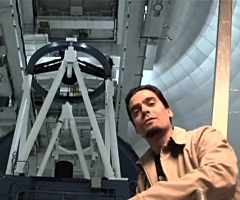
With more than a 15-year career as an astrophotographer, Vicent Peris (Valencia, Spain, 1980) has been working for the last 7 years at the Astronomical Observatory of the University of Valencia (OAUV). He is now leading the world-renowned astrophotographic programs at Calar Alto Observatory (CAHA) with the 3.5 meter and 1.23 meter Zeiss telescopes, the latter in collaboration with the Documentary School of Astrophotography (DSA), applying innovative image processing techniques and software tools. This is the first astrophotography project in the world with access to the observational time of professional telescopes.
You can see some of the published images of the Calar Alto project on the Gallery section of PixInsight's website, as well as some of Vicent's articles about his image processing techniques on the Processing Examples section.
His works have been published and awarded by some of the most reputed publications worldwide, such as APOD, Scientific American, National Geographic, Bad Astronomy Blog, and Sterne und Weltraum.
Vicent is also the official astrophotographer of the ALHAMBRA Survey, a deep cosmological survey conducted by an international scientific collaboration, acquired from Calar Alto Observatory using the 3.5 meter Zeiss telescope. This survey is the first in the world to use a new instrumental technique known as photometric redshifts, in which low-resolution spectra for each object in an image are obtained by using a large, 23 narrow-filter set covering the 3500 – 9500 angstrom light band. You can see some image samples at Vicent's website.
Vicent has also successful experience in forensics and is currently working as an image processing specialist for the Spanish National Police department since two years.
For more information about Vicent's works, please download his portfolio.




